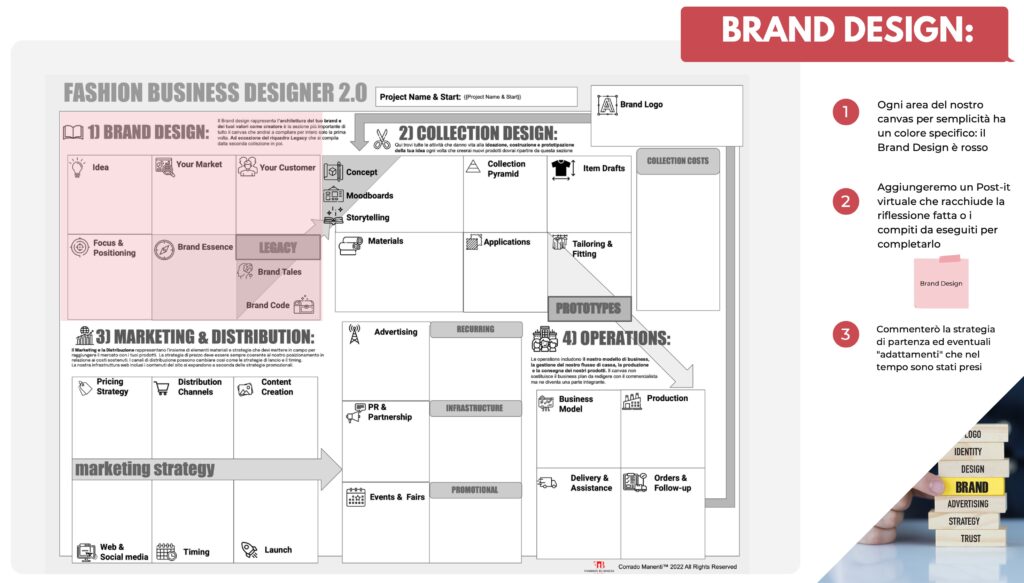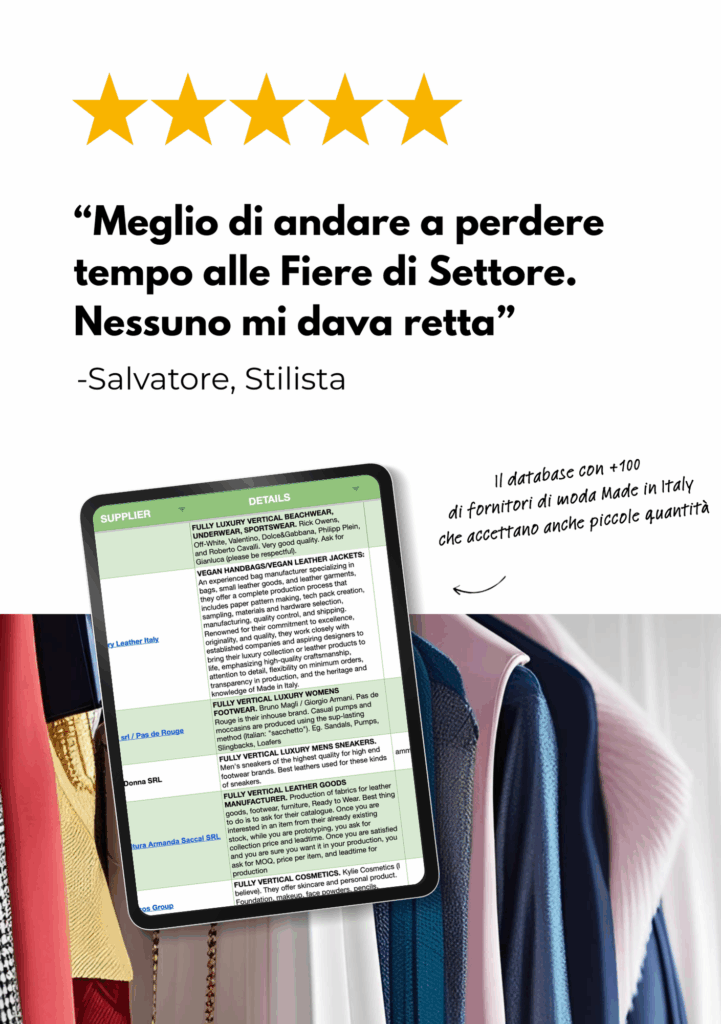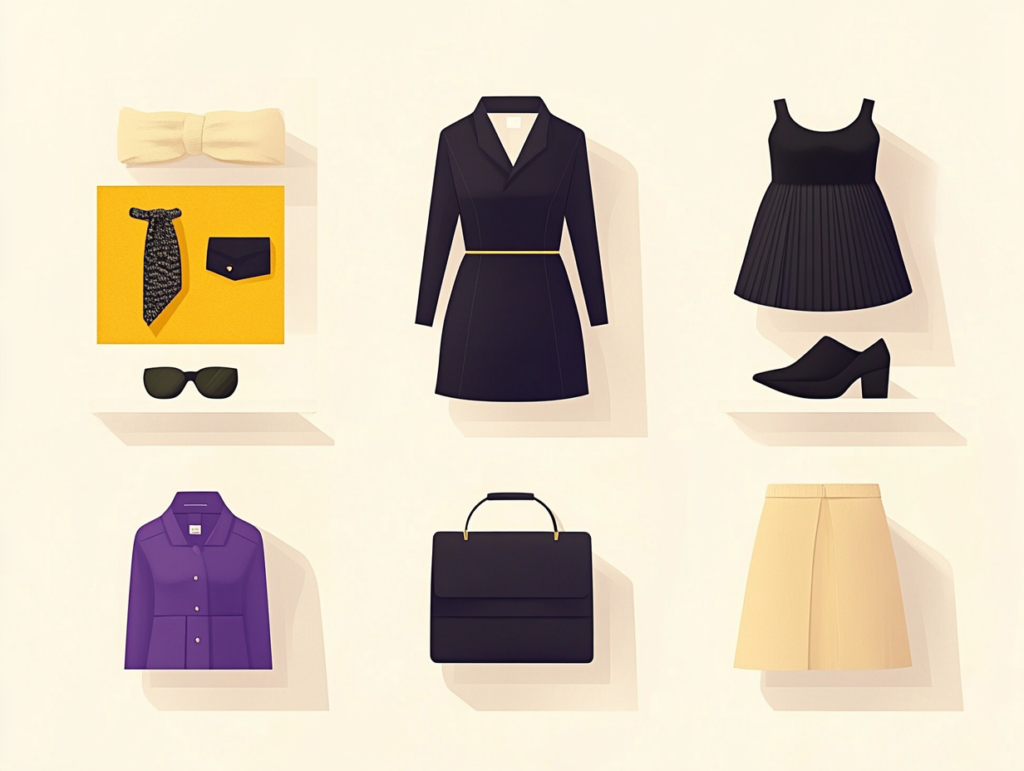La vera sfida di chi vuole diventare stilista nel 2026 non è creare una collezione, è vendere.
Ciao! Sono Corrado Manenti, imprenditore e stratega nel mondo della moda, con un’ampia esperienza nella creazione e gestione di brand di successo. Sono il fondatore di My Scarf in a Box™ e il co-fondatore della società Evolve Marketing srl, ed è per questo che sono considerato “l’eminenza grigia” dietro molti brand emergenti di fama mondiale.
Nel 2016, ho fondato Be A Designer, il primo ufficio stile dedicato esclusivamente agli stilisti emergenti. BAD offre un supporto prezioso e una guida ai talenti emergenti nel mondo della moda, aiutandoli a navigare nel complesso panorama del mercato e a realizzare il proprio potenziale creativo.
Nel 2023, ho dato vita alla Fashion Business Academy, la prima accademia digitale dedicata alla formazione su come creare un business nella moda e diventare imprenditori.

L’Origine di Questa Guida
Questo articolo rappresenta l’inizio del mio viaggio nel mondo della formazione per stilisti emergenti. L’ho scritto anni fa, prima ancora che esistesse il mio ufficio stile Be A Designer.it, quando stavo muovendo i primi passi nell’aiutare altri designer a realizzare il loro sogno. Le riflessioni e le strategie qui contenute sono poi diventate la base per il mio libro Best Seller “Anche tu vuoi fare lo stilista”, che potete trovare e acquistare a questo link.
La vera sfida di chi vuole diventare stilista non è creare una collezione, è vendere. I sette modi per lanciare la tua collezione (E il tuo Brand) sul mercato ti guideranno attraverso questo percorso cruciale. Ricordati che nella moda molte volte il tuo ruolo come Fondatore e Brand si fondono! Quindi ti consigli di approfondire anche come costruire il tuo personal brand in questo articolo!

Quando il Sogno Incontra la Realtà del Business
There is a moment in every designer's life where dreams and expectations of success brutally meet reality and the market: we are talking about the moment of the sale.
Come diceva Tommy Hilfiger:
«Essere uno stilista di successo è molto di più che creare dei bei vestiti. È riuscire ad avviare un business, ciò significa avere una combinazione di varie abilità, ti servirà la creatività, il senso per gli affari, abilità relazionali nel saper avere a che fare e gestire gli altri, abilità gestionali e la cosa più importante ti servirà la dedizione e la disciplina nel portare avanti le tue idee».
Se sei appena uscito da una scuola di moda e sei nuovo al mondo “reale” del business potresti venire molto turbato dalla verità che possiamo riassumere nella frase del Maestro della vendita Frank Merenda:
"A freelancer is a salesman. His job is to find customers to sell to. His profession, i.e. his technical skills, are his product."
Frank Merenda -Selling Sucks-.
La comprensione dei sette modi per lanciare la tua collezione (E il tuo Brand) sul mercato è cruciale per il tuo successo. In questo articolo farò il mio meglio per raccontarti come vedo io le cose dal mio punto di vista di Brand Designer quando lavoro sia con nuovi clienti, sia con business e aziende strutturate.
Se sei curiosa/o di sapere cosa faccia di precisio il Brand Designer (termine che ho coniato nel lontano 2015) trovi qui l’articolo dove ne parlo.

I Sette Modi per Lanciare la Tua Collezione sul Mercato
1. Siti Web / Piattaforme Ecommerce
Tutti noi siamo degli ottimi compratori online, questo ci porta a credere che gli altri compreranno facilmente il nostro prodotto su internet ma sarà davvero così? Dal momento che il lancio di Internet virtualmente ci basta un sito dove i consumatori possano acquistare.
Come un negozio nel mondo reale ha bisogno di mostrare le sue vetrine su una strada trafficata per vendere, anche noi con il nostro sito dovremo fare in modo di far arrivare e attrarre tramite i nostri canali e la pubblicità molti potenziali clienti per avere delle vendite.
Due approcci possibili:
- Dal nostro sito: Il sito è un elemento fondamentale nella costruzione del tuo brand
- Da altri siti / Piattaforme multi brand: Possiamo proporre i nostri prodotti ad altri siti e-commerce
2. App Mobile
La piattaforma direct-to-consumer in più rapida crescita in questo momento. Con gli smartphone ampiamente utilizzati è possibile sviluppare un’app a cui le persone possono rivolgersi direttamente e acquistare.
3. Commercio all’ingrosso
Ci sono grandi gruppi di negozi con i relativi buyer, purtroppo non è sempre facile trovare l’interlocutore giusto. Per quanto tutti a parole dicano di sostenere il made in Italy e i giovani designer nella pratica nessuno si fida di un brand che nessuno conosce. Molti negozi però possono essere interessati alle tue proposte, magari per iniziare in “conto vendita”.

4. Commercio all’ingrosso su piattaforme Online
Esistono piattaforme online apposta per brand emergenti che con una quota mensile ci permettono di caricare i nostri prodotti e mostrarli a negozianti o compratori di catene di negozi. Non tutte sono affidabili e producono risultati in tempi brevi, ma è sicuramente uno strumento in più.
5. Trunk Shows / Eventi / In home party
Portare i campioni direttamente ai clienti e quindi prendere gli ordini è un modo molto sicuro per costruire la tua attività. Non hai siti web, app o costi all’ingrosso né devi portare l’inventario. Naturalmente sei limitato dal numero di persone presenti all’evento ma la tua capacità di mantenere alti i tuoi margini rende questo un modo molto attraente per vendere il tuo prodotto.
6. Fiere di Settore / Mercatini
Ci sono un gran numero di fiere e mercatini in tutta Italia dove è possibile noleggiare uno stand e mostrare il proprio prodotto ai clienti diretti o negozianti. Il problema è che la competizione sarà altissima e sarà difficile (ma non impossibile) farti vedere. Non conoscendo te e il tuo brand la maggior parte degli incontri e della gente che si fermerà al tuo stand sarà casuale.
7. Temporary Store / Showroom
Nelle grandi città puoi trovare Temporary Store o Showroom dove esporre la tua merce. La differenza è che un Temporary store è come dice il nome “un negozio temporaneo” dove tu insieme ad altri brand puoi esporre i tuoi prodotti che verranno venduti ai clienti finali.

WE USE THE FASHION BUSINESS DESIGNER:
Before we start looking at the seven ways to market your collection, I want to show you where we are in the canvas.
Sales strategies and channels are in the third quadrant, the one on the bottom left dedicated to marketing and distribution of our products. If you are using the Fashion Business Designer it will be in this section where you go to work and put your post-its.
If you DO NOT KNOW the Fashion Business Designer is the methodology I created to help you develop your idea into a sustainable business model. It is a big board that gives you a complete view of what you are doing. You print it out in a nice big size, hang it on the wall and stick post-its on it as your collection takes shape.

You can find it here videos and free resources.
There are only three strategies you can adopt before choosing how to launch your collection.
- You can sell directly using traditional channels or via online
- Or sell to shops or chain shops and let them sell to the end consumer
- Or try to do both (complicating your life enormously)
Se non Hai ancora trovato i fornitori per realizzare la tua collezione?
Questo articolo parla di come lanciare la tua collezione dando per scontato che tu ce l’abbia giià pronta tra le mani. Purtoppo dall’idea al prodotto non è sempre un percorso lineare, trovare i giusti fornitori può essere una sfida. Se sei interessato ad accedere al nostro network di fornitori abbiamo creato un database di fornitori made in italy aggiornato al 2025. Se vuoi saperne di più trovi tutte le informazioni QUI

Le Tre Strategie Fondamentali di Distribuzione
- Vendita diretta al cliente finale:
- Massimo controllo sulla brand experience
- Margini più alti
- Necessità di investire in marketing
- Gestione diretta della logistica
- Vendita attraverso intermediari:
- Accesso a un pubblico più ampio
- Minori costi di marketing
- Margini ridotti
- Minor controllo sulla presentazione del brand
- Strategia ibrida:
- Bilanciamento tra vendita diretta e indiretta
- Necessità di gestire potenziali conflitti tra canali
- Maggiore complessità gestionale
- Maggiore copertura del mercato

Il Prezzo Giusto: La Base di Ogni Strategia di Vendita
Prima di lanciarti nella vendita attraverso qualsiasi canale, devi padroneggiare l’arte del pricing. Come spiego dettagliatamente nel mio libro, dare il giusto prezzo alle tue creazioni non è solo una questione di costi di produzione e margini. È un’alchimia che deve tenere conto di:
- Il posizionamento del tuo brand nel mercato
- La percezione del valore da parte del cliente
- I margini necessari per ogni canale di distribuzione
- I costi fissi e variabili della tua attività
- La scalabilità della produzione
Il prezzo deve raccontare una storia coerente: troppo basso e il tuo brand perderà prestigio, troppo alto e rischierai di restare con il magazzino pieno. Nel mio libro “Anche tu vuoi fare lo stilista” dedico un intero capitolo a come costruire un pricing strategy efficace, ma il concetto chiave è questo: il prezzo deve permetterti di essere sostenibile in ogni canale di vendita che scegli.
Per esempio, se decidi di vendere attraverso negozi, il tuo prezzo deve considerare che:
- Il negoziante applicherà un ricarico del 2.2/2.5
- Dovrai prevedere eventuali sconti stagionali
- Potrebbero esserci costi di rappresentanza o showroom
- Dovrai mantenere una coerenza tra canali diversi

Come Scegliere la Strategia Giusta
Come spiego nel dettaglio nel mio libro “Anche tu vuoi fare lo stilista”, la scelta dei canali di distribuzione dipende da vari fattori:
- Il tuo budget iniziale
- La complessità gestionale che puoi sostenere
- Il tuo target di mercato
- La tua capacità produttiva
- Le tue competenze di marketing

Conclusioni e Prossimi Passi
Mentre esplori i sette modi per lanciare la tua collezione (E il tuo Brand) sul mercato, ricorda che non esiste una formula magica. Il successo dipende dalla tua capacità di adattare queste strategie al tuo specifico contesto e alle tue risorse.
Se vuoi approfondire questi concetti e scoprire strategie più avanzate per il lancio del tuo brand, ti invito a leggere il mio libro completo “Anche tu vuoi fare lo stilista”, disponibile a questo link. Inoltre, attraverso BeADesigner.it, offriamo consulenze personalizzate per aiutarti a implementare queste strategie nel tuo business.
Punti Chiave da Ricordare:
- La vendita è importante quanto il design
- Ogni canale ha i suoi pro e contro
- La strategia multi-canale richiede attenzione ai conflitti
- Il marketing deve essere adattato al canale scelto
- La raccolta dati dei clienti è fondamentale
Come Creare un Brand di Moda di Successo nel 2025?
Il successo di un brand di moda emergente dipende dalla capacità di bilanciare creatività e strategia commerciale. Nel mio libro esploro in dettaglio come avviare un marchio di moda partendo da zero, un percorso che ho visto compiere a centinaia di stilisti attraverso il lavoro nel nostro studio stilistico www.beadesigner.it

Business Plan Moda: La Chiave per il Successo
Un business plan per un brand di moda non è solo un documento formale. È la roadmap che ti guida dal concept alla realizzazione. Nel settore moda, il business plan deve includere:
- Analisi del mercato moda italiano e internazionale
- Strategie di marketing per brand di moda emergenti
- Piano di produzione moda made in Italy
- Strategia di vendita moda online e offline
Fashion Startup: Come Lanciare il Tuo Brand
Lanciare una fashion startup richiede una comprensione profonda del mercato moda contemporaneo. Nel mio libro “Anche tu vuoi fare lo stilista” spiego come:
- Sviluppare un concept moda innovativo
- Creare una collezione moda sostenibile
- Implementare strategie di digital marketing per la moda
- Gestire la produzione moda in Italia
Ne ho parlato anche in questo articolo che è diventato un vero e proprio “classico” e pietra miliare del mio approccio di lavoro con i nuovi business e gli stilisti emergenti.

Come Diventare Stilista di Successo: La Dura Verità
Il percorso per diventare stilista oggi è molto diverso dal passato. Non basta più essere creativi: bisogna essere imprenditori della moda a 360 gradi. E lasciatemelo dire chiaramente: creare da soli in Italia, senza un aiuto concreto, un VERO brand di moda partendo da zero, senza solide competenze tecniche, di marketing, commerciali, di business e senza un budget importante alle spalle è praticamente impossibile.
Lo vedo ogni giorno nel nostro ufficio stile: siamo in trincea e in prima linea con decine di stilisti e brand emergenti, e tutti si trovano sempre nella stessa situazione. Una corsa infinita contro il tempo e contro il mondo intero per cercare di compensare gli errori fatti in principio quando hanno creato il loro brand e la loro prima collezione.
Se sbagli all’inizio è tutto incredibilmente più difficile, credimi.

La Fashion Business Academy: Un Nuovo Approccio al Successo nella Moda
C’era davvero bisogno di un’altra accademia di moda? La risposta è sì, ma non per i motivi che potresti pensare.
Come formatore, consulente e creatore del mio brand My Scarf in a Box, ho vissuto personalmente le sfide e le delusioni degli stilisti emergenti. Ho provato l’entusiasmo di creare, ma ho anche sperimentato la frustrazione di vedere i miei sforzi vanificati.
La Fashion Business Academy nasce da questa esperienza diretta. Non è solo un altro corso di moda – è un percorso completo che:
- Ti accompagna nella lettura e nello studio pratico del libro “Anche tu vuoi fare lo stilista”
- Ti fornisce gli strumenti concreti per affrontare le sfide dell’industria
- Ti inserisce in una comunità di stilisti emergenti pronti a sostenersi reciprocamente
- Ti offre una mentalità imprenditoriale, non solo competenze tecniche
Non posso prometterti soluzioni miracolose o formule magiche per ottenere un successo immediato. La moda è un mondo complesso e altamente competitivo, e non esistono scorciatoie. Quello che posso offrirti è la mia esperienza, le mie conoscenze e le strategie che ho affinato nel corso degli anni.

Perché Scegliere la Fashion Business Academy?
- Esperienza Diretta: Non teoria, ma strategie testate sul campo
- Supporto Continuo: Una comunità di professionisti al tuo fianco
- Approccio Pratico: Strumenti concreti per il tuo successo
- Mentalità Imprenditoriale: Non solo tecnica, ma visione di business
- Network: Connessioni reali nel mondo della moda
Voglio essere il tuo alleato, la tua guida nel mondo della moda. So cosa significa lottare, so cosa significa sentirsi perso e insicuro. Ma so anche che con la giusta conoscenza, le giuste competenze e il giusto supporto, puoi trasformare la tua passione per la moda in un vero e proprio business di successo.
Il Tuo Prossimo Passo Verso il Successo
Se sei pronto a intraprendere questo viaggio, ti invito a dare una possibilità alla Fashion Business Academy. Non è solo un investimento in un corso – è un investimento nel tuo futuro come stilista di successo.
[BOTTONE DI ISCRIZIONE ALLA FASHION BUSINESS ACADEMY]
"If you don't have a system to sell you will remain at the mercy of the customer's buying system".
David Sandler

Quanto costa lanciare un brand di moda in Italia?
Come si inizia a vendere una collezione di moda?
Quanto deve essere grande una prima collezione moda?
Come si trova il primo produttore per un brand di moda?
Come si calcolano i prezzi per una collezione moda?
È possibile lanciare un brand di moda solo online?
Quanto tempo ci vuole per lanciare un brand di moda?
Come si protegge legalmente un brand di moda?
Quali sono i canali di vendita più efficaci per un brand emergente?
Come si crea un business plan per un brand di moda?
Seguire i sette modi per lanciare la tua collezione (E il tuo Brand) sul mercato può guidarti verso il successo.




11 thoughts on “I sette modi per lanciare la tua collezione (E il tuo Brand) sul mercato”
Hi, I deal in handmade jewellery made in sicily... how could I propose my creations to a shopkeeper? Is it better to sell in bulk, or to leave what we consider to be the strong points of the collection, in his shop, and then give the sale a percentage?
Hello I am in charge of a clothing brand how can I make it known, and find outlets as a wholesaler, can you advise me?
Good evening, how can I contact you to collaborate on the creation and sale of my collection? Thank you.
Good evening you can contact us from this link below to be contacted: https://calendly.com/beadesigner/conosciamoci?month=2021-01
Or write an e-mail to [email protected]
Hello, I would like to ask a question. I have dreamed of being a fashion designer for a long time, but unfortunately I cannot afford education at a university or fashion academy. Since 2018 I have been taking part in a sewing course, to refine my technique, and I have a lot of talent to show. How can I make myself stand out? I can do many things drawing, sewing and much more.
I am acquiring my art diploma at the evening high school and then plan to enter university in the meantime I would like to work in the fashion industry as I acquired my regional vocational qualification in the industrial clothing sector in 1999 I would like to design brands and sew them
I pose a question. Is it true that the facon costs of a collection are billed at twice the rate of mass production? In other words, can a subcontractor charge a higher figure for making a collection garment?
Hello Thank you for your comment! The answer is "it depends". Usually there is a surcharge even of 50% between a sample cost and a production cost, usually Facon is always influenced by quantities and obviously the more you produce the lower the cost of making. If you are a subcontractor account you should always have a higher figure to make a collection garment (sample or prototype) also because if you work with big brands most of the time they produce the samples in Italy and then go and produce them in Romania etc. I hope I have answered your question! If you want to know more, please write to me: [email protected]
I want to sell my fabric designs as farem7
Good morning I would like to know which trade fairs are suitable for launching a line of eco bags made from recycled materials such as coffee pods
Hi, I have just realised my first beacwer collection. At the moment it is on sale in a showroom and will soon be available online on e-commerce, but how can I expand my sales network and offer my product to other shops or abroad?